The IWC Pilot’s Watch Chronograph U.S. Navy Squadrons Editions (Live Pics & Price)
Three ceramic chronographs for civilians inspired by collaborations with U.S. Navy Squadrons fly into the brand’s Pilot’s Watch collection.
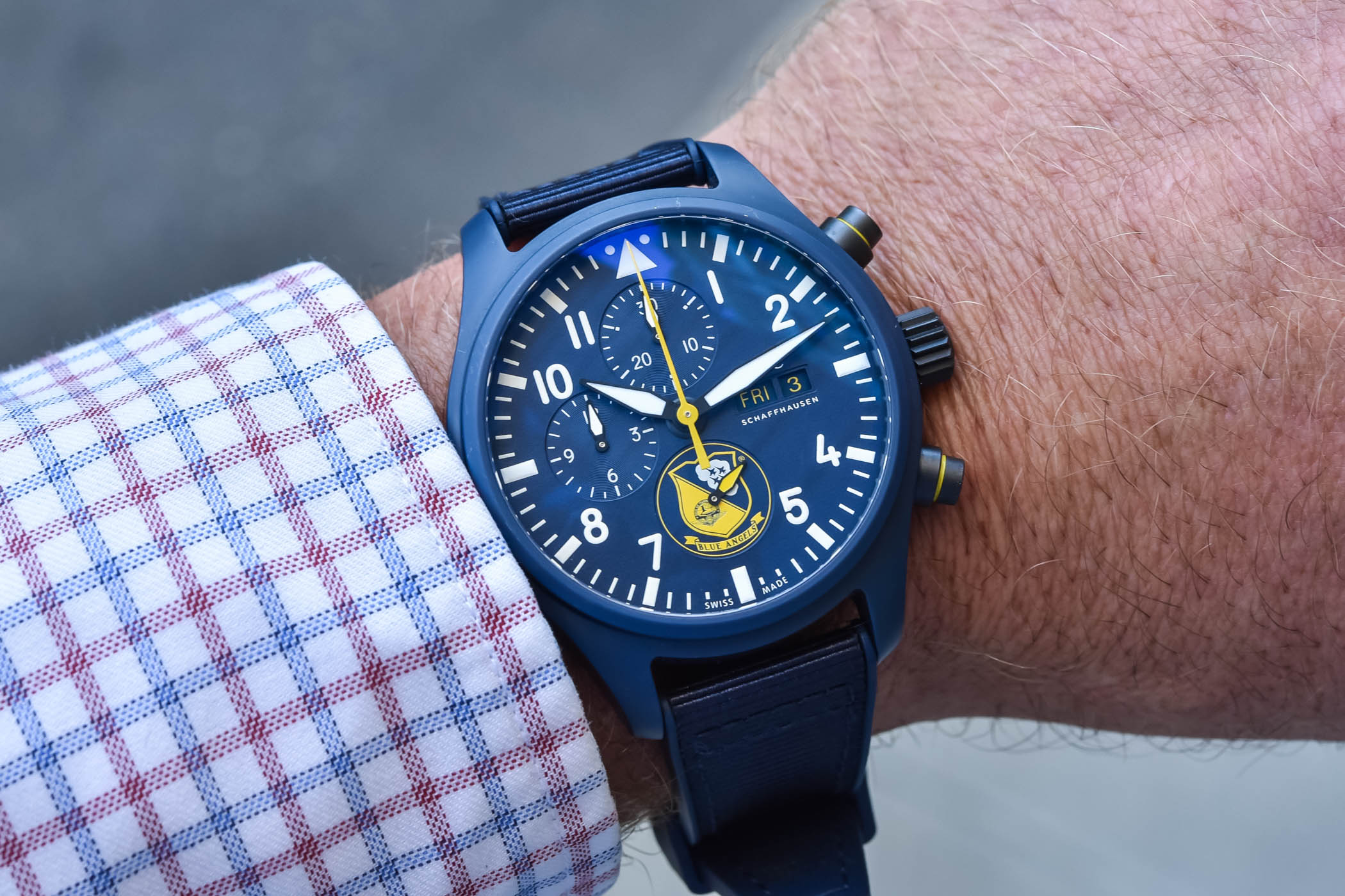
For over 85 years, with the introduction of its first aviation timepiece in 1936, IWC Schaffhausen has been flying high with its pilot’s watches. Since then, IWC has been perfecting the functional requirements of the Flieger watch with first-hand feedback from pilots, a crucial factor in developing mil-spec service watches. Today, the Schaffhausen-based brand releases three new ceramic chronographs directly inspired by the brand’s collaborations with U.S. Navy squadrons. Marking the first time these squadron watches are available for civilian wrists, the chronographs fly the colours and squadron patch of three U.S. Navy and Marine corps aviation units: “Royal Maces”, “Tophatters” and “Blue Angels”. Rugged 44.5mm ceramic cases and sealed titanium casebacks engraved with the squadron’s patch protect the brand’s latest column-wheel chronograph movement.
Legitimate aviation watches
Contrary to many watch brands that produce aviation-inspired watches without any real ties to aviation, IWC collaborates directly with military programmes and receives vital feedback from pilots to improve a watch’s performance in the cockpit. Producing purpose-built wrist instruments from 1936, like the “Special Watch for Pilots”, the WWII Observation watches and Mark XI Navigator’s Watch for the RAF, IWC has earned its wings. During the 1930s and 1940s, IWC played an important role in establishing the cockpit-instrument look of pilot’s watches with the white luminescent triangular index with two dots at 12 o’clock set against a matte black background.
In 2018, IWC received a license to produce watches for U.S. Navy and Marine Corps aviation units and has collaborated with more than a dozen squadrons to produce special editions exclusively for active pilots and veterans.
“Royal Maces”
Stationed at Marine Corps Air Station Iwakuni, Japan, this Strike Fighter Squadron 27 (VFA-27) forms part of Carrier Air Wing 5. Known as the “Royal Maces”, this Super Hornet fighter squadron was formed in 1967, and its insignia is a gloved hand holding a black mace on a black and yellow background, often emblazoned on the tail of the Super Hornet.
Taking design cues from the military edition developed with members of the squadron and the colours of the squadron’s insignia, the latest civilian version of the chronograph has a 43.5mm matte black zirconium oxide ceramic case with Ceratanium® pushers and crown and bold yellow details. Ceramic is widely used throughout the watchmaking industry, mainly for its remarkable scratch-resistant properties, but the natural black layer formed after subjecting zirconium to high temperatures is also anti-reflective. In addition to this, the pushers that operate the chronograph functions are developed from IWC’s proprietary Ceratanium® material. It delivers the light and durable properties of titanium but also the hard, scratch-resistant qualities of ceramic. IWC has balanced the chronograph dials at 12, 6 and 9 o’clock with a day and date feature at the third hour. Luminous central hands and Arabic numerals around the dial’s periphery have been treated with luminescence to assist with timekeeping during night flights or in low-light conditions.
The vivid yellow details can be appreciated on the squadron patch in the small seconds counter at 6 o’clock and its yellow hand, in the day and date window at 3 o’clock, on the pushers, on the tip of the central seconds hand and even on the stitching and inside lining of the black calfskin strap. The reverse side of the watch is sealed with a grade 5 titanium caseback engraved with the squadron’s F/A-18E Super Hornet jet.
“Tophatters”
The Strike Fighter Squadron 14 (VFA-14) was formed in 1919 and is the Navy’s oldest active squadron and lives up to its motto as “the oldest and boldest”. Based at Naval Air Station Lemoore, California, the squadron is nicknamed “Tophatters” and flies F/A-18E Super Hornets.
With an identical black zirconium oxide case to the “Royal Maces”, the“Tophatters” plays with a black, white and red colour scheme. The black top hat of the squadron’s patch is placed inside the small white seconds counter at 6 o’clock, indicated with a bright red hand. Red is also used for the day and date, the tip of the central seconds hand, the rings on the pushers and the stitching and lining of the black calfskin strap. Also sealed with a grade 5 titanium caseback, the engraving features a top hat in the centre and the inscription “Tophatters”, “Boldest”, “Oldest”, and “Est. 1919”.
“Blue Angels”
The “Blue Angels” are the United States Navy Flight Demonstration squadron and the second oldest aerobatic team in the world, after the French Patrouille de France (formed in 1931).
Like other demonstration squadrons, its role is to perform aerial displays and “to showcase the pride and professionalism of the United States Navy and Marine Corps by inspiring a culture of excellence and service to country”. With 141 members from the Navy and Marine Corps, demonstration pilots fly six single-seat F/A-18 Hornets in more than 70 shows throughout the United States each year. Painted in blue with dynamic gold details, the F/A-18 Super Hornets used for demonstrations are slightly different from combat versions: the gun system is removed, and the aeroplanes are equipped with smoke generators to highlight the manoeuvres.
Marking the squadron’s 75th anniversary this year, the “Blue Angels” have flown an immense variety of aircraft. They started with the F6 Hellcat, the F8 Bearcat, and the F9 Panther. During the 1950s, they refined their demonstrations in the F9 Cougar and F-11 Tiger and introduced the first six-plane delta formation, a spectacular aerobatic manoeuvre that they still fly today. By the end of the 1960s, the “Blue Angels” were flying the F-4 Phantom before transitioning to the A-4 Skyhawk. In 1986, the year of their 40th anniversary, they transitioned to the F/A-18 Hornet. In 2021, the “Blue Angels” transitioned to and now perform in the F/A-18 Super Hornet. Every one of their jets showcases blue and gold, the official colours of the U.S. Navy.
IWC became an official licensee of the Department of the U.S. Navy in 2018 and has collaborated with the Navy to design two special edition chronographs: the 2019 Pilot’s Watch Chronograph Edition “Blue Angels” (Ref. IW389008) in black ceramic and this latest edition to coincide with the 75th anniversary of the “Blue Angels” this year.
Inspired by the military watch developed with Blue Angel members in Pensacola, Florida, the new chronograph dons a bright blue ceramic case with the U. S. Navy Wings of Gold crest in the small seconds counter picked out in yellow and white against a blue background. Yellow is also used on the entire length of the central seconds hand, the small seconds hand, the rings on the chronograph pushers and the day and date window at 3 o’clock. Unlike the other two models, the Pilot’s Watch Chronograph Edition “Blue Angels” (Ref. IW389109) comes on a blue rubber strap with a textile inlay.
“New Standard” Chronograph movement
This integrated column-wheel chronograph – calibre 69830 – is the new standard for all IWC chronograph watches, a departure from the old and outsourced Valjoux 7750-based movements. The easiest way to distinguish the two from the dial side is the new position of the small seconds sub-dial, now at 6 o’clock instead of 9 o’clock. Equipped with a bi-directional pawl-winding system to supply the movement with a 46-hour power reserve and a column wheel to control the stopwatch function, the calibre 69380 is protected from magnetic fields by a soft-iron case.
Availability & price
Limited to an annual production of 500 pieces each, the Pilot’s Watch Chronograph Edition “Royal Maces”, “Tophatters” and “Blue Angels” will be available from September 9 through IWC boutiques, authorised retail partners or online on IWC.com. The retail price is CHF 11,900.

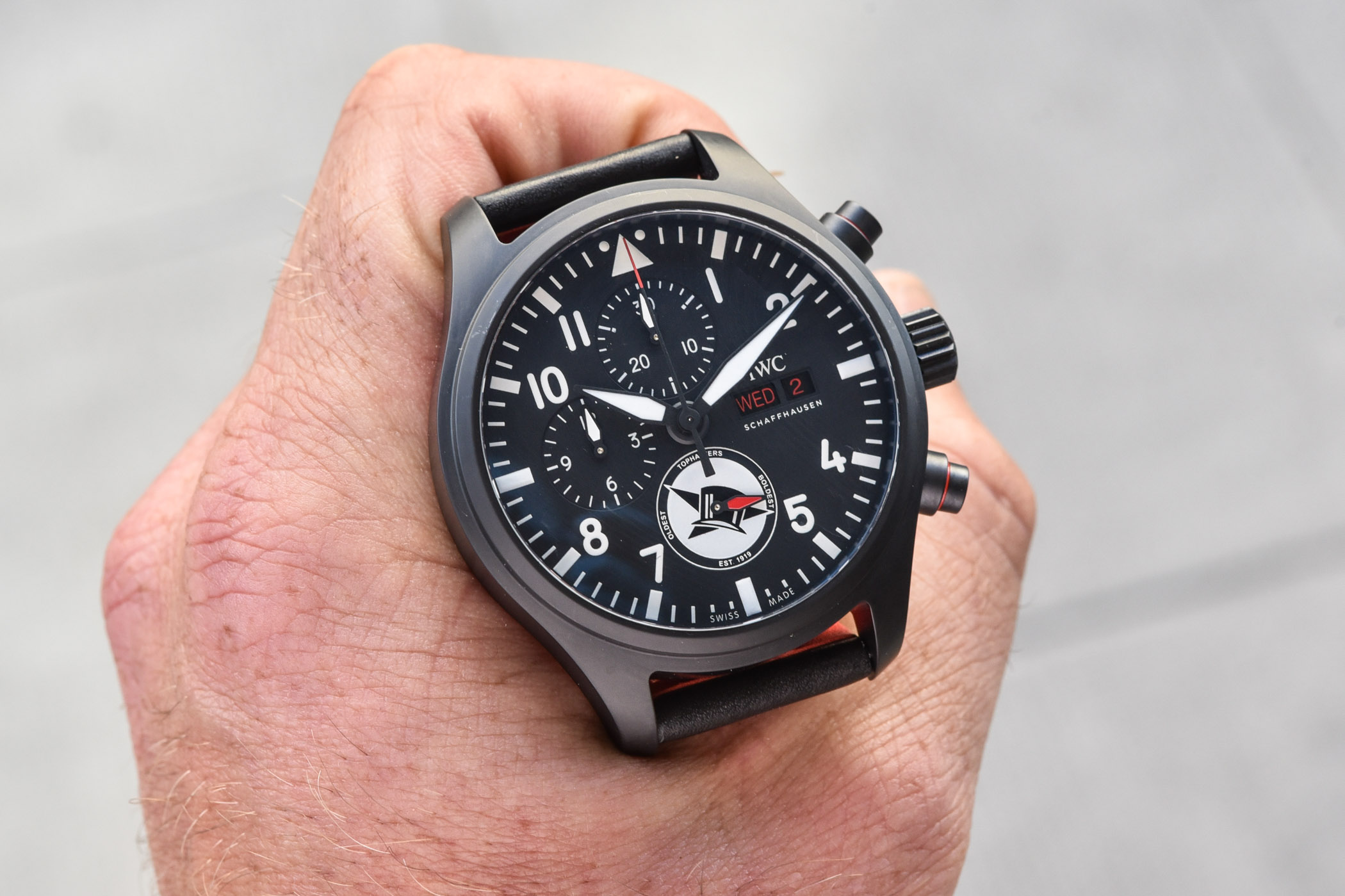
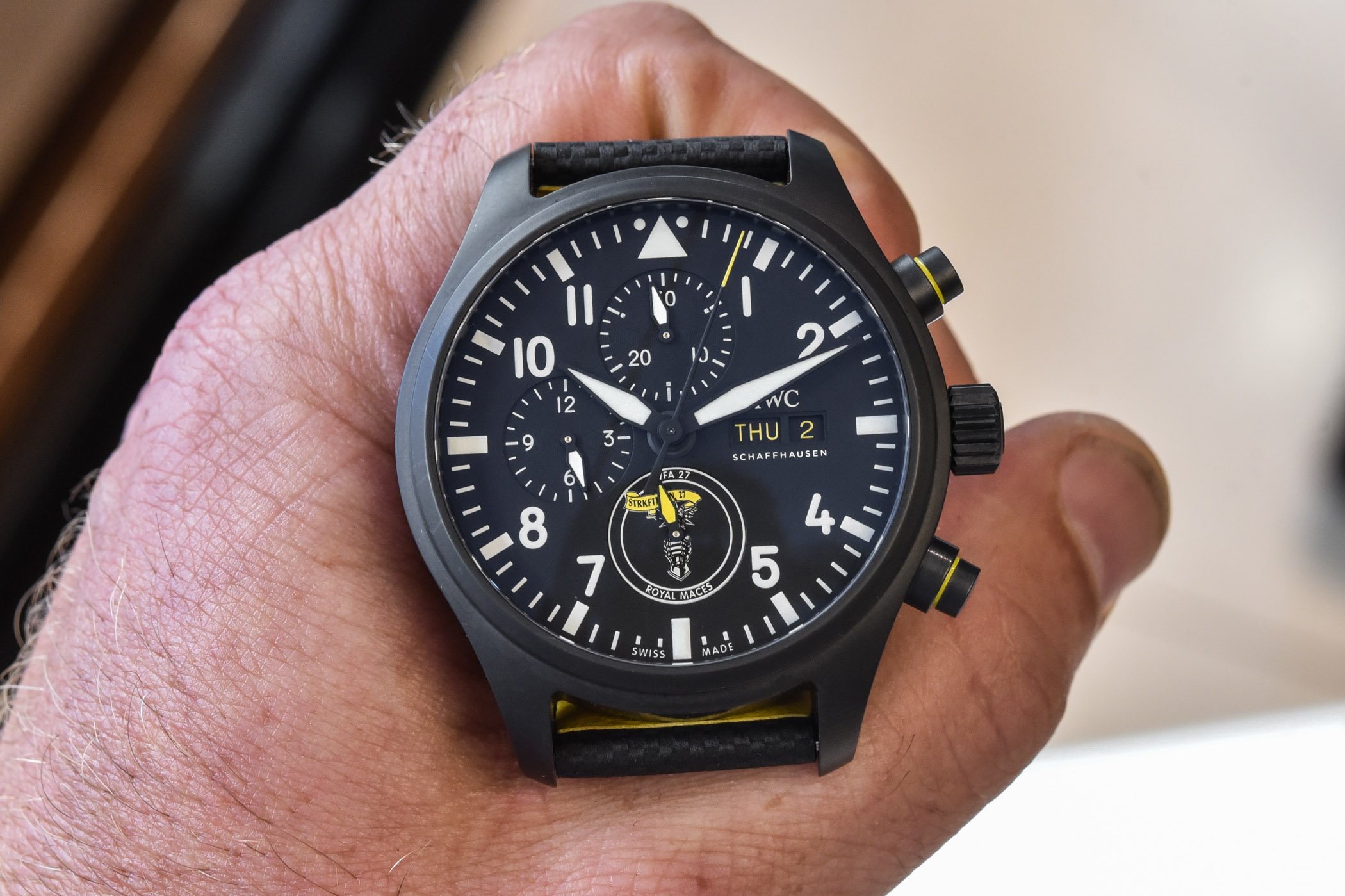
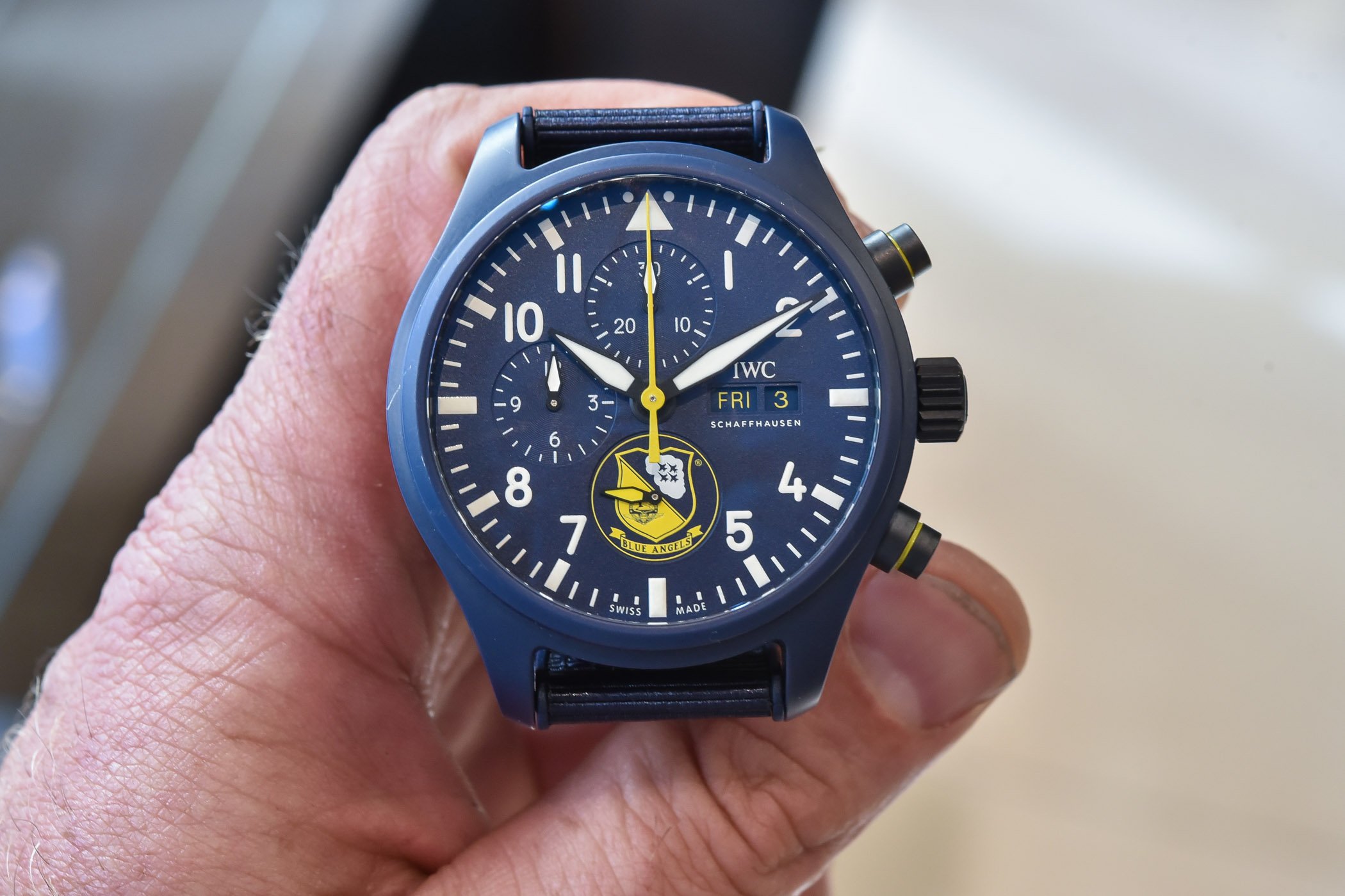
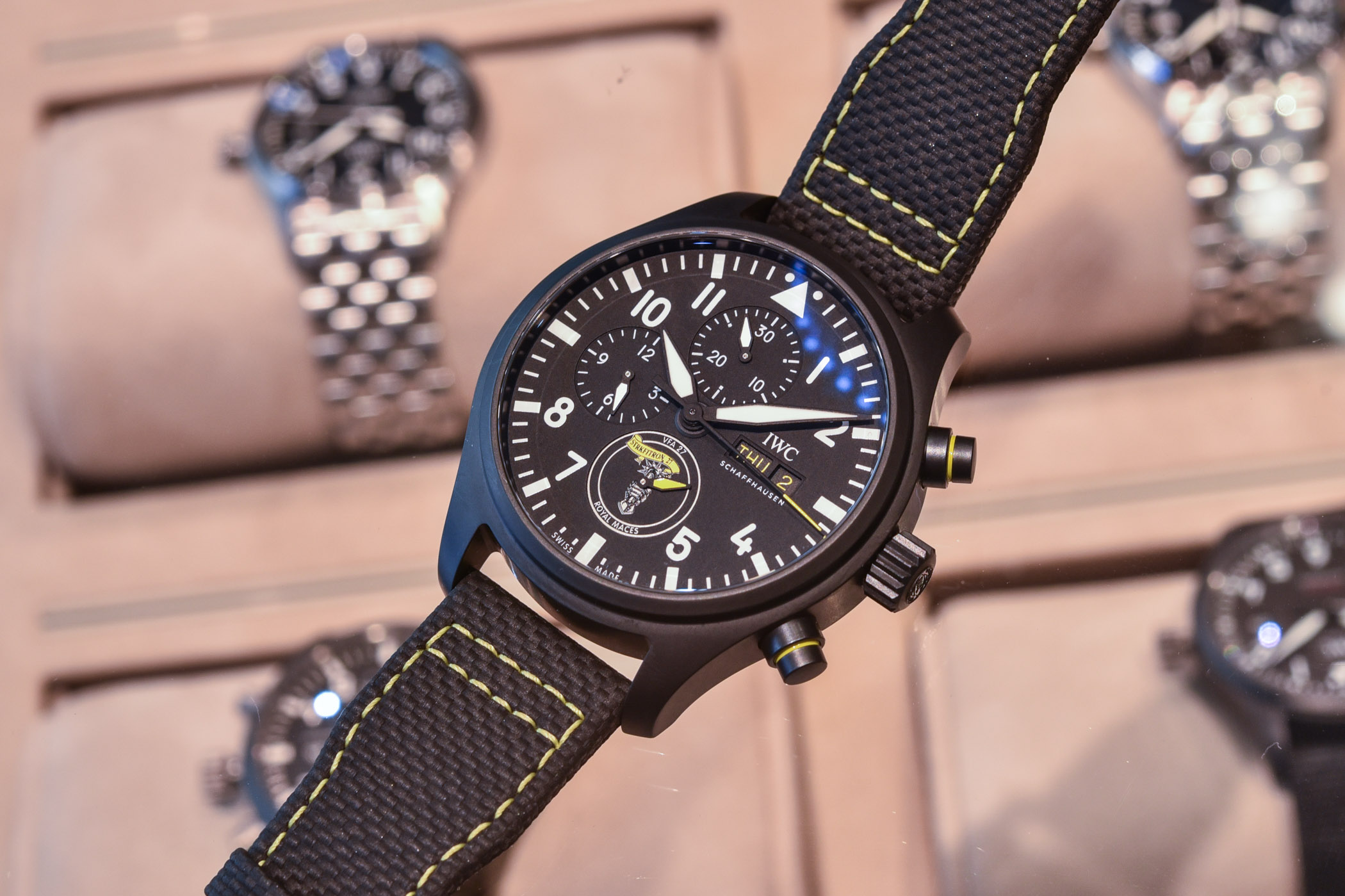
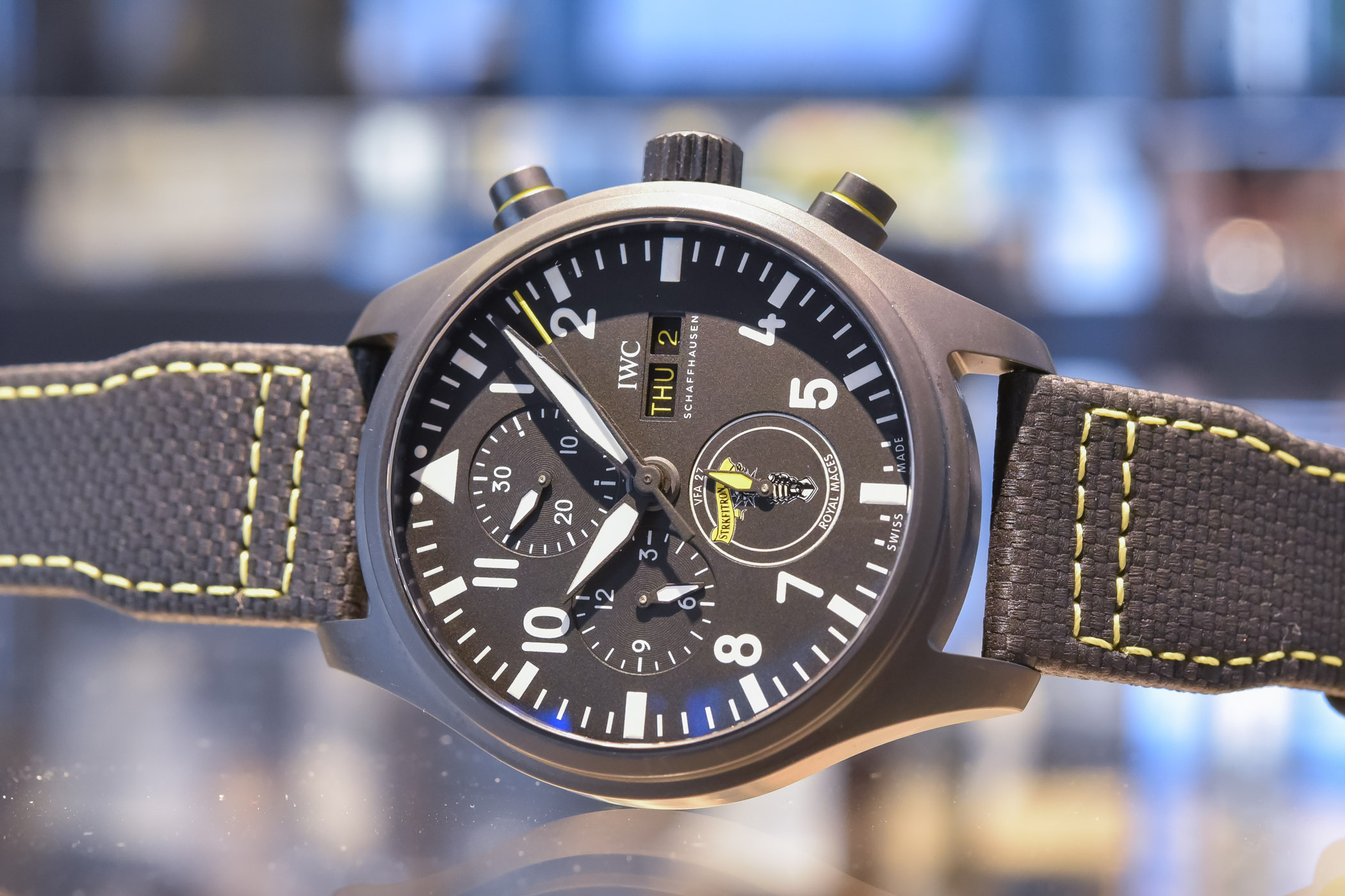
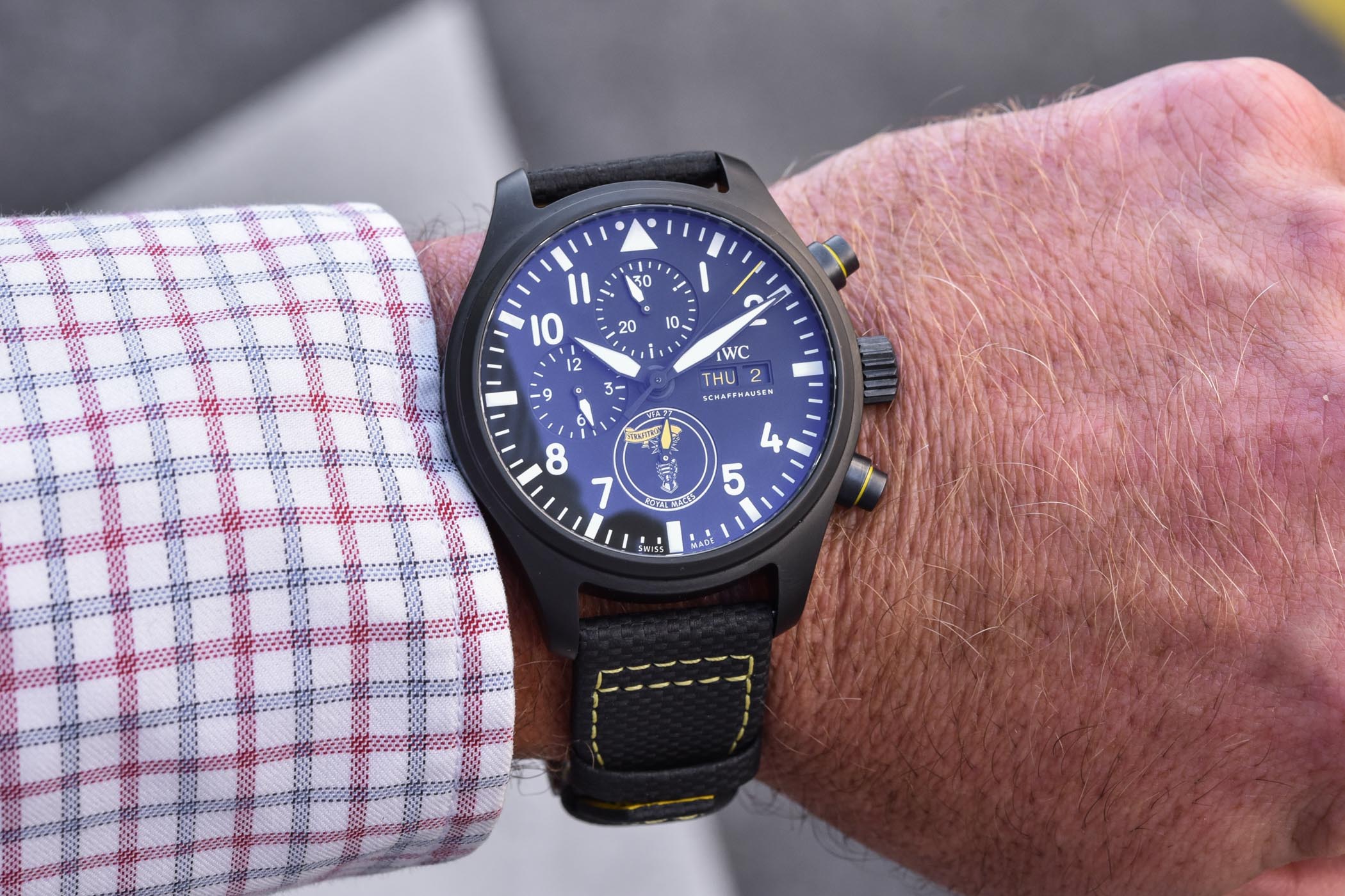

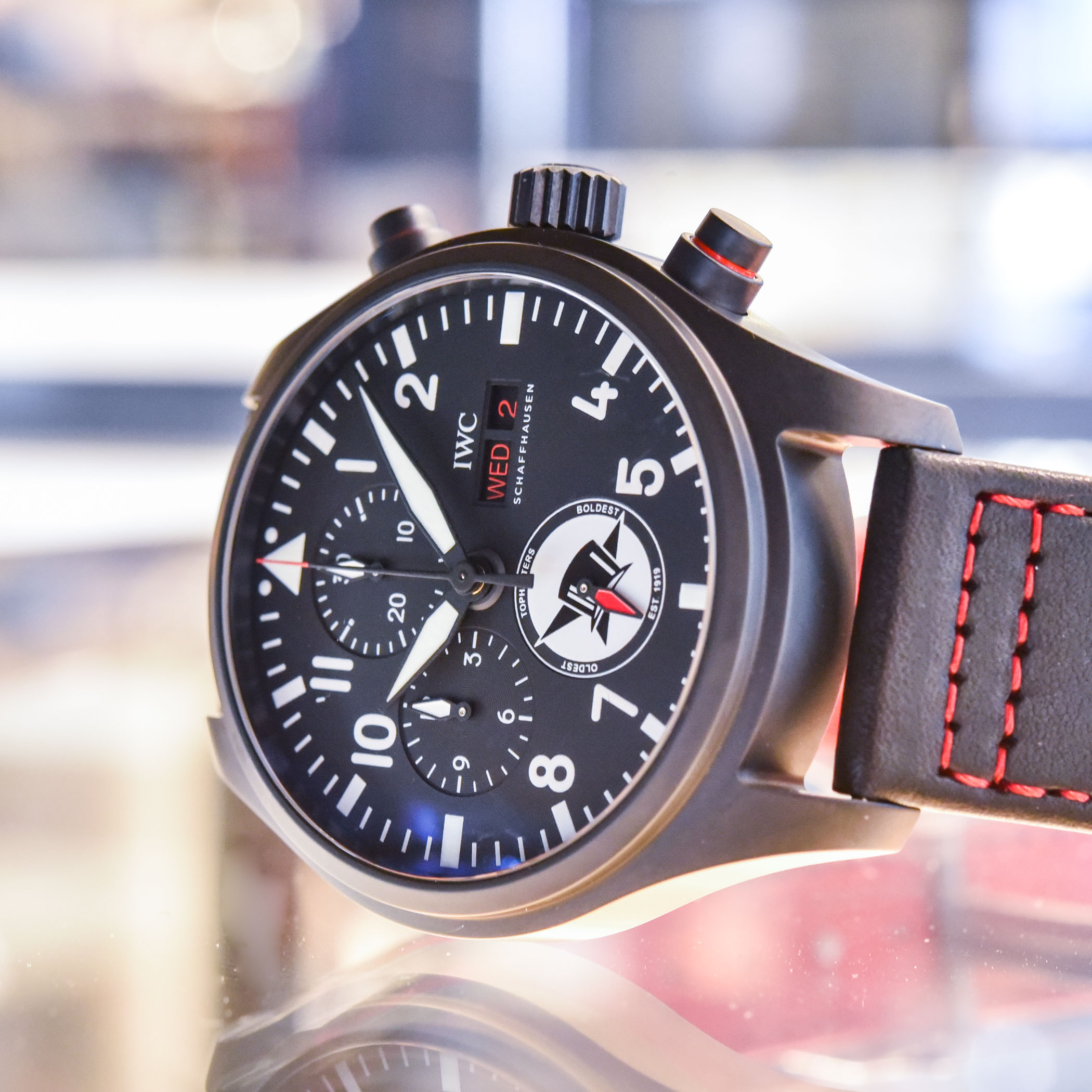
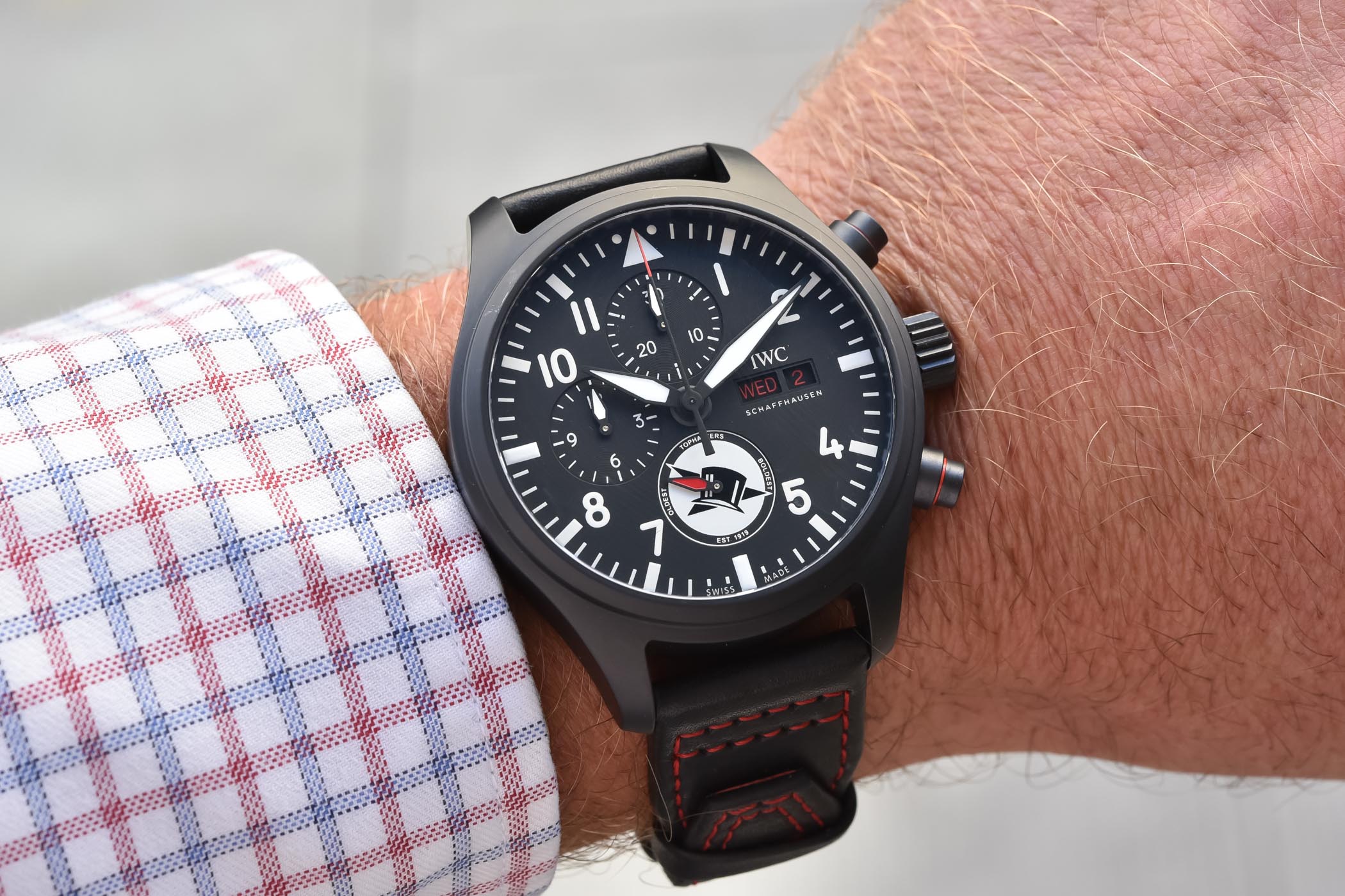
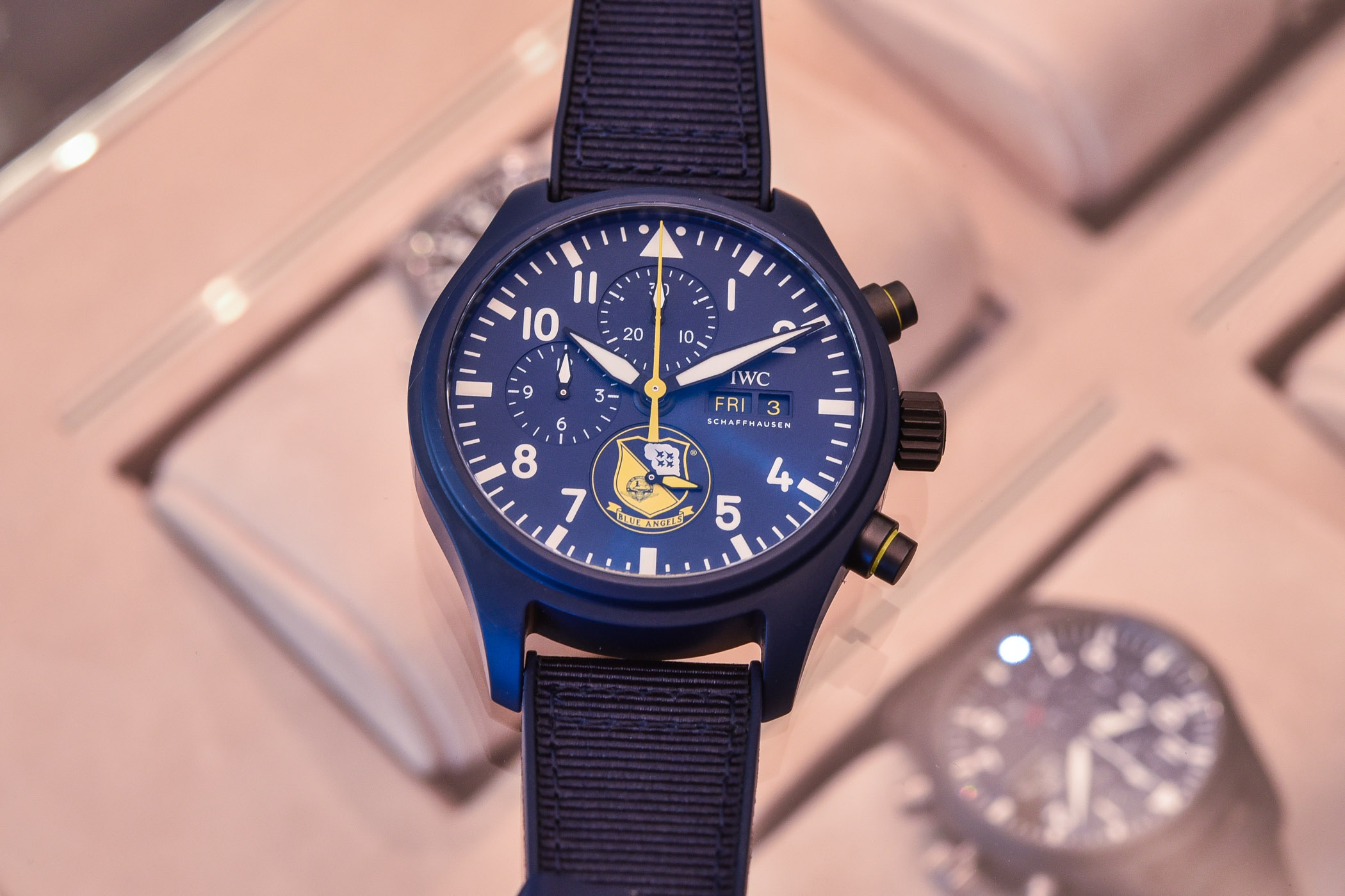

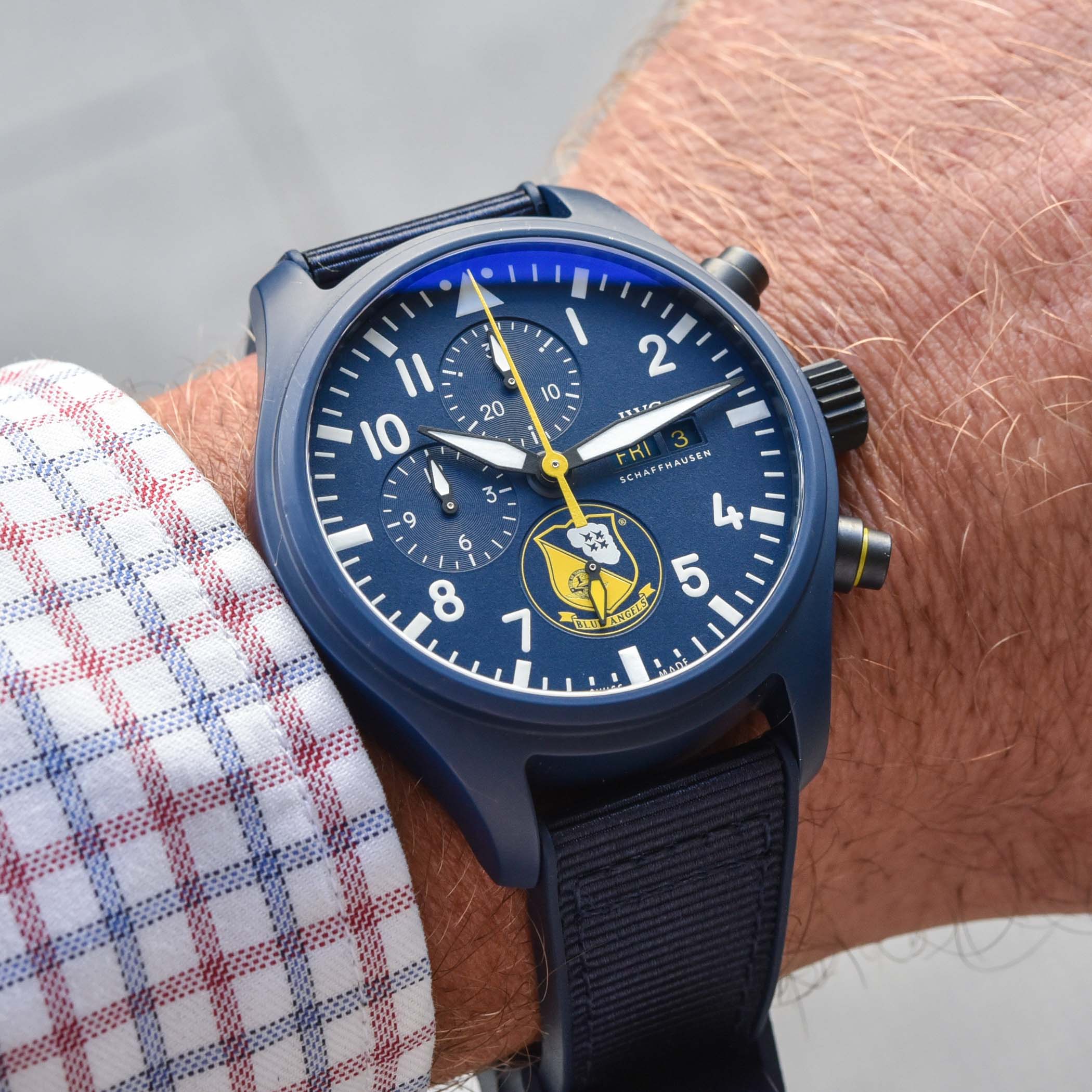



5 responses
If IWC disappeared tomorrow it would be no loss. Klaus’ and Habring’s work was invaluable, but now…the company is a zombie.
Very very true gav
They keep milking the pilot’s line to the point i don’t bother to pay attention anymore. While they abandoned their potential future classic like Ingenieur….and how about Aquatimer that is long due? Is IWC now a Pilot Watch manufacturer? I had high hope for their new CEO back then. Seems that he is forced to follow the marketing guys.
All these never ending limited/special editions are becoming really boring and pointless. What are they thinking? What’s next? Charlie Chaplin Pilot chronograph?
Absolutely ridiculous!!
Have mercy! haha. There are some serious haters here. This was or brand is clearly not for you. Every brand has a staple… this is IWC’s.
A squadron insignia is the perfect match for those collectors who like military aviation. Most good insignia watches are usually available to the actual squadrons, and they do not usually like civilians getting them.
I would love to see a F-14 Tomcat stamp on one of these, though that is more of a plane and not a squadron. It reminds me of growing up next to a naval base and seeing jets doing maneuvers.
If you are going to use WW1 aviation references, then how about Manfred von Richthofen or Eddie Rickenbacker, and not an actor (Though I think a Charlie Chaplin watch would be pretty cool).
I will be in the minority here, but I’m used to that. haha